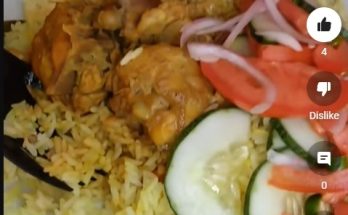
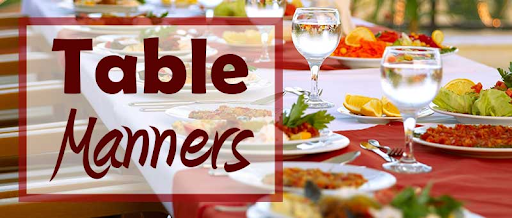
Table Manners
100s of “how-to” lists and lists with the best table manners tips! Our experts have read hundreds of books and articles, along with asking the opinion of table manners experts, to create a comprehensive resource. Descriptive images and infographs make understanding every table manners topic easy and fun!
Napkin Etiquette
At informal meals, place the napkin in your lap immediately upon seating. During formal occasions, before unfolding the napkin, wait for the hostess to remove her napkin from the table and unfold it in her lap.
- Place the napkin in your lap upon seating.
- When leaving the table temporarily, put the napkin on your chair.
- At the meal’s end, fold your napkin and place it to the left of your place setting.
Read more tips for using your napkin in the napkin etiquette section.
Handling Utensils
How do you hold a fork?
The continental style prevails at all meals, formal and informal, because it is a natural, non-disruptive way to eat.

- Hold your fork in your left hand, tines downward.
- Hold your knife in your right hand, an inch or two above the plate.
- Extend your index finger along the top of the blade.
- Use your fork to spear and lift food to your mouth.
At informal meals the dinner fork may be held tines upward, American table manners style.
The Table Setting
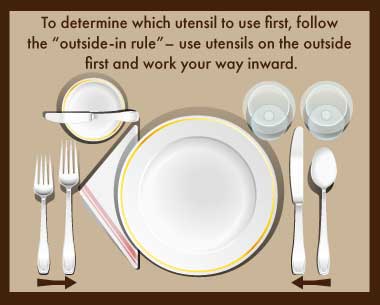
Deciding which knife, fork, or spoon to use is made easier by the outside-in rule – use utensils on the outside first and working your way inward. So, if you are served a salad first, use the fork set to the far left of your plate.
Your water glass is the one above the knife in your place setting and your bread plate is to the left. To remember which bread plate belongs to you and if the glass in front of you belongs to you or your neighbor, use “b” and “d”. Touch the index finger on your right hand to your right thumb. Touch the index finger on your left hand to your left thumb. The “b” formed by your left hand is for “bread” (your bread plate is always at the left of your place setting). The “d” formed by your right hand is for “drink” (your drinking glasses are always at the right of your place setting).
Our table setting section discusses in greater detail what you’ll see at the table.
When to Start Eating
At a small table of only two to four people, wait until everyone else has been served before starting to eat. At a formal or business meal, you should either wait until everyone is served to start or begin when the host asks you to.
Resting Utensils
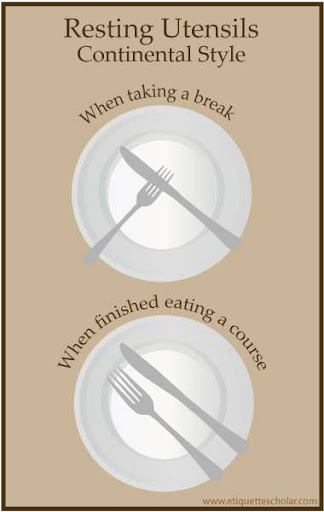
How do you leave your knife and fork on your plate when taking a break or are finished eating?
When you pause to take a sip of your beverage or to speak with someone, rest your utensils in one of the two following styles:
Continental Style: Place your knife and fork on your plate near the center, slightly angled in an inverted V and with the tips of the knife and fork pointing toward each other.
American Style: Rest your knife on the top right of your plate (diagonally) with the fork nearby (tines up).
When each course is finished:
Place the knife and fork parallel with the handles in the four o’clock position on the right rim of the plate.
Passing Food Etiquette
Pass to the right (if the item is not being passed to a specific person). One diner either holds the dish as the next diner takes some food, or he hands it to the person, who then serves herself. Any heavy or awkward dishes are put on the table with each pass.
Bread Passing Etiquette
- If the loaf is not cut, cut a few pieces, offer them to the person to your left, and then pass the basket to your right.
- Do not touch the loaf with your fingers, instead use the clothe in the bread basket as a buffer to steady the bread as you slice it.
- Place the bread and butter on your butter plate – yours is on your left – then break off a bite sized piece of bread, put a little butter on it, and eat it.
Salt and Pepper Etiquette
Always pass the salt and pepper together.
Soup Etiquette
Hold the soupspoon by resting the end of the handle on your middle finger, with your thumb on top. Dip the spoon sideways at the near edge of the bowl, then skim away from you. Sip from the side of the spoon. To retrieve the last spoonful of soup, slightly tip the bowl away from you.
Seating Etiquette
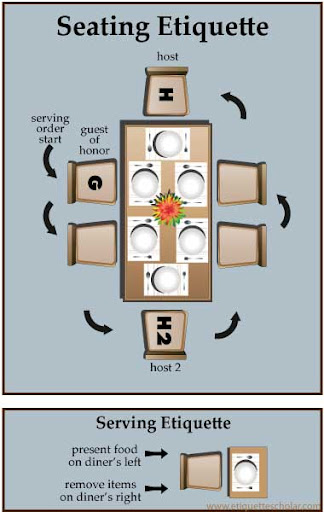
Your host may have seating arrangements in mind, so you should allow him to direct you to your seat. As the host, you should suggest the seating arrangements.
In a restaurant, the guest of honor should sit in the best seat at the table. Usually that is one with the back of the chair to the wall. Once the guest of honor’s seat is determined, the host should sit to her left. Other people are then offered seats around the table.
Food Service Etiquette
During service of a formal dinner, the food is brought to each diner at the table; the server presents the platter or bowl on the diner’s left. At a more casual meal, either the host dishes the food onto guests’ plates for them to pass around the table or the diners help themselves to the food and pass it to others as necessary.
Meals End
At a formal affair, plates are removed by a professional staff. But as most informal meals are served without help, the hostess clears the plates, often with the help of a guest or two. At a family meal, members clear their own plates.
Clearing the Plates
- If the meal is formal, plates will be removed by the staff.
- At informal meals, the hostess will probably clear the plates, possibly with one or two guests helping.
- At a family meal, members clear their own plates.
Leaving the dining room. To signal dinner is concluded, the hostess catches the eye of the host, lays her napkin on the table, and suggests that everyone go into another room for coffee and after-dinner drinks. The hostess rises from her chair.
When it’s time to leave, rather than detain one’s host with a lengthy good-bye, make the departure brief but cordial.
Utensil Etiquette
Handling Utensils
In most situations, following the “outside-in” rule will tell you which knife, fork, or spoon to use at the dinner table.
- Use utensils on the outside first and work your way inward with each new course that is served.
Continental Style v. American Style
(for right-handed dinners)
Continental Style
Hold your fork in your left hand, tines downward.
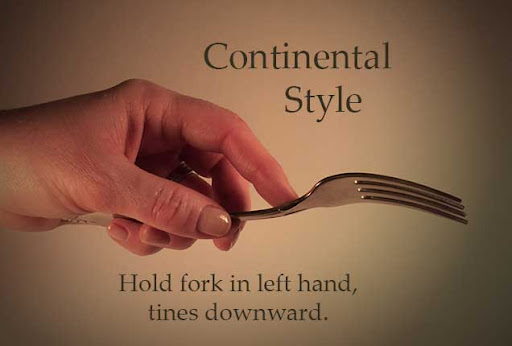
Hold your knife in your right hand, an inch or two above the plate. Extend your index finger along the top of the blade.
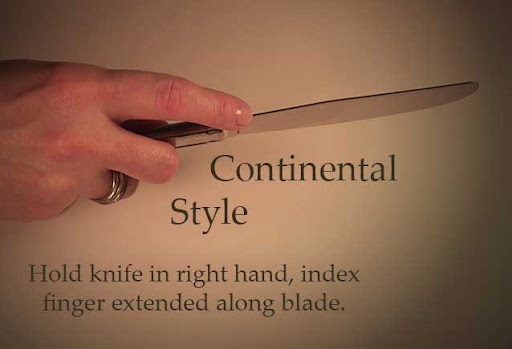
Use your fork to spear and lift food to your mouth.
If your knife is not needed, it remains on the table.
American Style
Hold your fork like a pencil, with the shank extended between your thumb and index and middle fingers. Your fourth and fifth fingers rest in your hand.
For leverage, the index finger is extended along the back of the fork, as far from the tines as possible.
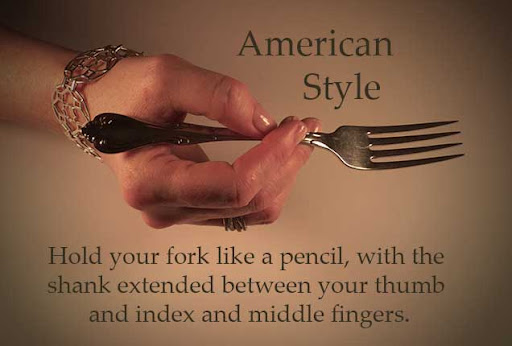
Hold the knife with the handle cupped in the palm of your left hand, along with your third, fourth, and fifth fingers. Place your second finger on the back of the blade. Hold your thumb against the side of the handle.
https://www.etiquettescholar.com/dining_etiquette/table_manners.html


